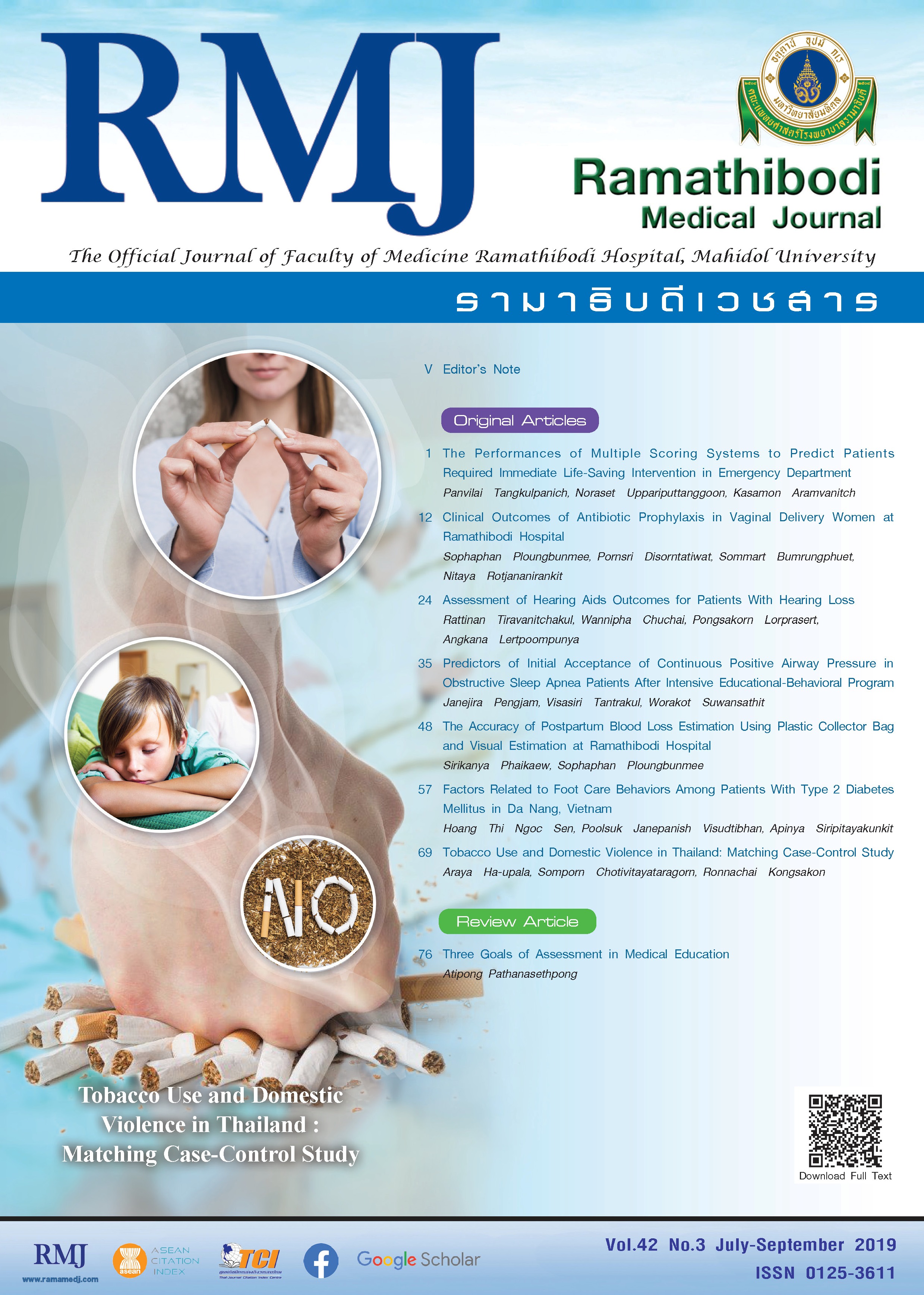Assessment of Hearing Aids Outcomes for Patients With Hearing Loss
DOI:
https://doi.org/10.33165/rmj.2019.42.3.169111Keywords:
Outcomes, Indicators, Hearing aids, Hearing lossAbstract
Background: Age-related hearing loss is a vital problem that impacts daily living including communication, socialization, and wellbeing. To be fitted with appropriate hearing aids can certainly improve quality of life. Therefore, it is essential to develop a set of indicators that will be used to measure hearing aids outcomes.
Objectives: To determine the effectiveness of hearing-aid outcomes and to examine common hearing aid problems.
Methods: A retrospective analysis of medical records of 634 patients receiving hearing aids services at Ramathibodi Hospital from July 2015 to June 2016, was performed. Data were collected using a data collection form and were examined by conducting descriptive analysis and paired t tests. Common hearing aid problems were analyzed using qualitative content analysis.
Results: Of 634 patients receiving hearing aids services, the average hearing thresholds and speech recognition scores among with and without hearing aids, across a range of hearing loss, were statistically significant (P < .01). Patients’ satisfaction on hospital services, and on hearing aids were 4.64 and 4.34, respectively. Common hearing aid problems were communication strategy, hearing aid manipulation, and routine maintenance of hearing aids and/or ear molds.
Conclusions: Patients receiving hearing aids services from Ramathibodi Hospital reported better speech sound hearing and communication. They were satisfied with hospital services and hearing aids on defined indicators.
References
World Health Organization. WHO global estimates on prevalence of hearing loss; Mortality and Burden of Diseases and Prevention of Blindness and Deafness WHO, 2012. https://www.who.int/pbd/deafness/WHO_GE_HL.pdf. Accessed March 8, 2019.
National Statistical Office (NSO). The 2014 Survey of Older Persons in Thailand. Bangkok: National Statistical Office; 2014.
Ciorba A, Bianchini C, Pelucchi S, Pastore A. The impact of hearing loss on the quality of life of elderly adults. Clin Interv Aging. 2012;7:159-163. doi:10.2147/CIA.S26059.
National Health Security Office. Budget management for medical rehabilitation services manual for fiscal year 2015. https://www.nhso.go.th/files/userfiles/file.pdf. Accessed March 8, 2019.
Thai Speech-Language and Hearing Association. Professional Ethics and Standards of Thai Speech-Language and Hearing. Khonkaen: Khonkaen Print; 2000.
ASHA Ad Hoc Committee on Hearing Aid Selection and Fitting. Guidelines for hearing aid fitting for adults. Am J Audiol. 1998;7(1):5-13. doi:10.1044/1059-0889.0701.05.
Solheim J, Kvaerner KJ, Sandvik L, Falkenburg ES. Factor affecting older adults hearing-aid use. Scand J Disabil Res. 2012;14(4):300-312. doi:10.1080/15017419.2011.640411.
Thanawirattananit P, Yimtae K, Prathanee B, Kasemsiri P, Piromchai P, Cadchumsang J. The study plan to increase the number and the proper distribution of communicative disorder experts. Health Systems Research Institute (HSRI); 2018. https://kb.hsri.or.th/dspace/handle/11228/4847?locale-attribute=th. Accessed March 8, 2019.
Northern JL, Downs MP. Hearing in Children. 4th ed. Baltimore, MD: Williams & Wilkins; 1991:285-320.
Dillon H. Hearing aids. 2nd ed. New York, NY: Thieme Medical; 2012.
Weinstein BE. Customer satisfaction with and benefit from hearing aids. Semin Hear. 1997;18(1):3-5. doi:10.1055/s-0028-1083003.
Erber NP. Use of hearing aids by older people: influence of non-auditory factors (vision, manual dexterity). Int J Audiol. 2003;42 Suppl 2:2S21-2S25.
Lupsakko TA, Kautiainen HJ, Sulkava R. The non-use of hearing aids in people aged 75 years and over in the city of Kuopio in Finland. Eur Arch Otorhinolaryngol. 2005;262(3):165-169. doi:10.1007/s00405-004-0789-x.
McCormack A, Fortnum H. Why do people fitted with hearing aids not wear them? Int J Audiol. 2013;52(5):360-368. doi:10.3109/14992027.2013.769066.

















